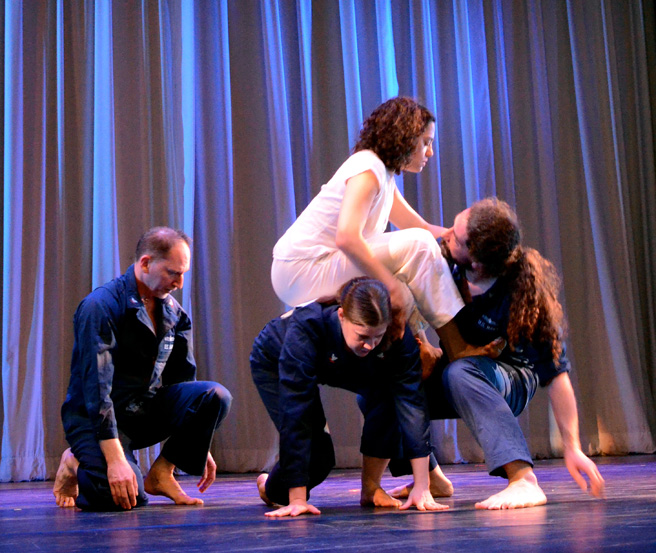Human Landscape Dance premiered "Icarus and Daedalus" at the Kennedy Center Millennium Stage on Wednesday March 23, 2011. Watch a video of this performance. They will perform an extended version on Friday May 18 and Saturday May 19 at 8pm in A Rugged Shore at Joe's Movement Emporium, 3309 Bunker Hill Rd, Mount Rainier MD.
The plot is familiar: Icarus and Daedalus escape the labyrinth in which they have been imprisoned by flying on homemade wings. Icarus gets caught up in the joy of movement: he flies too close to the sun. The wax on his wings melts and he plummets into the ocean. Daedalus searches for the boy's body, but never finds it. He flies to a nearby island to erect a monument to his son, then, the consummate survivor, Daedalus flies to safety.
Our dance explores this myth with special attention to the sometimes strained relationships of parents and children. Our Icarus, played by Amanda Abrams, flies in the arms of Daedalus. Daedalus is played by three dancers: Alex Short, Malcolm Shute, and Mary Szegda. Together, Daedalus carries, helps up, holds onto, swings, and variously supports Icarus, as a parent carries a child. An adventurous child, Icarus walks upon, leaps off of, and rolls over Daedalus. Daedalus struggles to keep Icarus from falling. So, as a parent, I struggle to protect my daughter, although she wants to explore on her own, and, as she grows, I will be unable to always catch her.
The dance is a series of swoops and swings. Abrams dives from one set of arms to another, clambers up on our backs, kicks away--only to be caught by a new body before she falls. There is a terrestrial quality to her flight: Abrams depends on the rest of the company to hold her up. Abrams clings to us as she uses our bodies to remain aloft. Like a child hopping from one piece of furniture to another across a living room, Abrams's flight is achieved through grounding, rather than air currents.
Icarus begins by stepping onto the back of Daedalus. All three Daedalus's form a moving walkway by sliding upon the floor. Icarus stares ahead, lost in the motion, while her parents haul her painstakingly, bellies pressed against the ground, hands pushing bodies along, inch by inch. She takes a step, pauses, thinks about the journey ahead: the airplane, the lines at security, the destination. She takes another small step.
When the flight begins, Icarus crouches upon Szegda's back. She rolls onto Short, then stands upon Shute's hips, shifting easily between bodies, roving from support to support. She falls against Szegda, to Short, steps onto Shute's back, leaps onto Short's shoulder, reverses into Shute's arms, then rolls into Szegda's. She is tossed in swirling currents, hurtling through space.
Later, after her fatal fall, Icarus rolls in the ocean waves below. Daedalus's three sides battle over how to react. Szegda and Shute would follow their child into the water; Short becomes a wall: he will not let anyone share Icarus's fate. Shute flings himself diagonally across Short, reaching for Abrams; he is flung back. Szegda flies forward, only to encounter Short's arms. Shute crawls beneath Short's guard, but is tossed head over heels against Short's back.
Our wishes for our children are so compelling and so far beyond our control. We pile up vain attempts to protect them until they are ready, knowing that readiness only comes through experience. We fling ourselves into a sky that will not hold us, come crashing down, yet try again.
Malcolm Shute
Artistic Director

